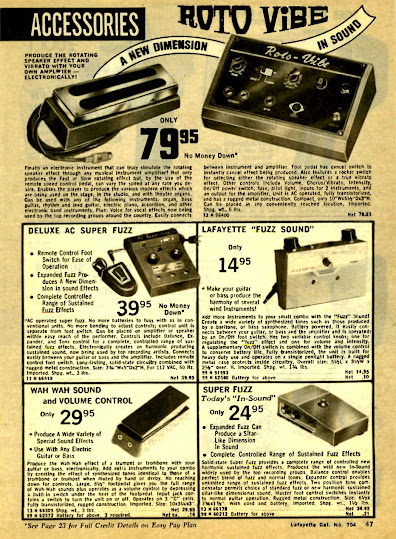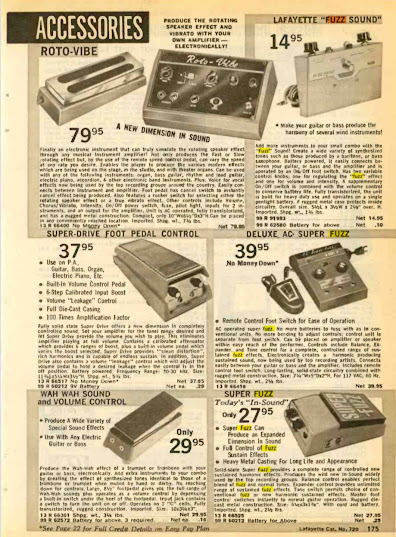☟
The lineage of Japanese effects is just difficult to research. Most of the available information leads you down a dark and endless tunnel system, splintering off in every direction; starting with a small syndicate of factories and ending with an almost infinite amount of brands, builders, labels, and products.
That all being said, I'm feeling pretty good about this one, and I think you may actually find a new nugget of information (or two).
So let's go!
As I write this, the true origin of Sekova as a company is still a bit of a mystery... The further I dug into this, the more tangled it all became. But here is what we do know; By the mid 60s a small builder based in Trumansburg, NY was producing cheap guitar amplifiers for the brand, in an attempt to capitalize on the Rock revolution (post Beatles/Ed Sullivan appearance). And this small builder, while relatively unknown at the time, would end up becoming one of the most influential minds of music technology in the 20th Century; his name, Robert Moog (yes! THAT Moog).
What is unclear is Moog's true involvement with Sekova. Was it a guitar-based offshoot of R.A. Moog Co.? His business partner Walter Sear had been importing and distributing brass instruments to the US since the 50's, so was Sekova his idea? Or, were they simply hired to manufacture the amps, leaving the distribution to Sekova? Sadly, we don't know any of this.

But what we do know is that in this Upstate NY workshop they were making all kinds of amps, with brandings like
Amper,
Encore Amplifiers, and
Sekova (originally named "Segova", until hit with a cease-and-desist from famed guitar player Andrés Segovia). We also know that Sekova was importing Japanese-built electric guitars as early as 1964, and Korean-built acoustic guitars at least that early.
But when it came to the amps, they were being made in the Moog "factory" in Trumansburg and then shipped to NYC, where Walter Sear and a few others would assemble them. Moog was always looking for ways to lower their costs, which eventually lead him to seeking out alternative part options overseas, from Japan. Unfortunately this would quickly come back to bite him in the ass, as they received hundreds of returns from angry customers due to the poor quality.
After a string of money-losing decisions, the Summer of 1966 also saw the demand for cheaply made guitar amps starting to wane. And the final blow to the project was the exceedingly exponential growth of competition in the amplifier market. This, combined with a strengthening Synthesizer business, pushed Moog to drop out of the guitar amplifier world for good, leaving Sekova behind in the process...
But just a year later the Sekova brand would reemerge, now fully owned and distributed by the U.S. Musical Merchandise Corp of New York, they expanded their array of guitars and accessories, and even included their first pedal, a Maestro Fuzztone copy called the
No. 59 Distortion Box (discussed at great length
HERE).
Throughout the rest of the 60s and 70s the U.S. MMC utilized Sekova to sell things like Les Paul copies, psychedelic picks, mandolins, autoharps and yep, amplifiers. But their biggest contribution to the guitar world was an intensely red-colored set of pedals and plugin effects (almost completely copied from Electro Harmonix circuits), with an oddly cold font choice, and completely manufactured in Japan by the Shin Ei group.
The true star of this series was 100% the no-f*cks-given named, "
Big Muff". Released in 1973 it was a nasty and dark-tuned version of the 1971 Triangle Muff circuit, with a size that dwarfed all the other effects in their lineup.
Sitting on a shelf this beast stares back into your soul, beckoning you to pick it up and plug it in; it's just so damn RED! And because of that, for a long time it was the subject of endless stompbox lore, rarely showing up for sale, and in the possession of only a very small group of collectors.
Even right now you can find old forum threads asking about a strange "Red Big Muff", and was it some unknown Electro Harmonix side project forgotten by time? It wasn't until the late 2000s when a few more of these finally showed up that we began to see the light, realizing it was a Japanese-made pedal, most likely from the early 70s, by Shin Ei and distributed by Sekova.
This particular Sekova Big Muff took me about 7 years to find.
They would rarely show up for sale, and when they did they were almost always beat to hell and rusted out. And even back then they were selling between $700-$1,000!
But luckily for me my competition for buying vintage pedals was significantly lower in the early 20-teens than it is today. And finally, in 2011 I scored this beautiful example of the Sekova Big Muff.
So how do they sound???
Well a couple of weeks ago we posted a super in-depth demo and review of one
HERE. But I'll also do my best to describe it in my own words.
Ok so as we mentioned above, this is a copy of the 1971 version of the Triangle Muff. The big differences circuit-wise are mainly the transistors used and the values in the tone stack.
This gives the Sekova a much darker, and louder volume overall than its older American cousin. It's great on big chunky chords, and even though it can flub-out on the low end and get a bit muddy, that's precisely the aspect of this fuzz that makes it awesome (and so damn heavy).
Rolling the guitar's tone back brings less gain but more breakup in the mid/high end; great for crunchy tube style overdrive. And turning the pedal's tone knob up reveals some sizzle on the high end, without sacrificing the lows. It really is a cool variation to the Muff circuit, and seems to be among many collectors' favorite fuzzes. But in the end, it plays with mostly the same character and aggressiveness of any Triangle Muff, with just a tiny bit of the finesse missing. And that's totally fine by me. :)
As you can tell from this writeup there is still a mountain of information to be learned about Sekova. What was their relationship with Shin-Ei? Where were these products sold? How many were made, and by who? And what really was the genesis of Segova as a brand?
Until next time; we'll just have to settle for what information we have, and all these cool photos to drool over...
 If you happen to have any additional info that would help clear up some these missing details, please shoot me an email
If you happen to have any additional info that would help clear up some these missing details, please shoot me an email!
Thanks for reading!
-ed






















